Pruning helps trees grow stronger and look neater and more attractive. The process of pruning plants can be physically demanding, but mental preparation and planning are the keys to success in this important skill.
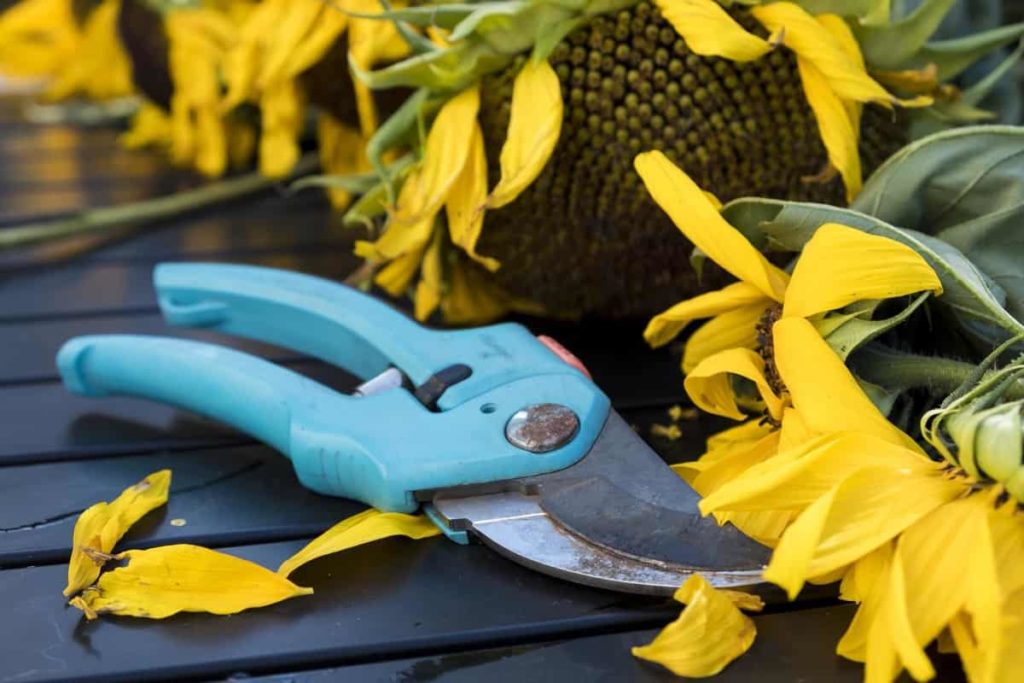
A guide to understand the Pruning of plants
What is the purpose of pruning?
Pruning removes dead and dying branches and roots, making room for new growth and preventing damage to your property and passer-by. It also prevents insect and animal infestation and promotes natural plant appearance and healthy growth. Established orchard practices, both organic and inorganic, typically involve pruning.
It can control growth, remove dead or diseased wood, and stimulate the formation of flower and fruit buds. Careful attention to pruning young trees is believed to improve their later productivity and longevity. Good pruning and training will prevent weak crotches or forks (where the tree trunk splits into two or more (or breaks into more branches) and can also prevent subsequent injuries that break from the weight of fruit.
Is pruning healthy for trees?
Regular pruning is essential for the overall health and beauty of your tree. It stimulates new growth. It increases air circulation, making healthier plants resistant to pests and diseases. On the other hand, trees can look unsightly with dead or diseased branches without pruning, leading to more serious problems like insect infestation and rot.
In case you missed it: Pruning In Agriculture – Benefits, Tips, and Ideas
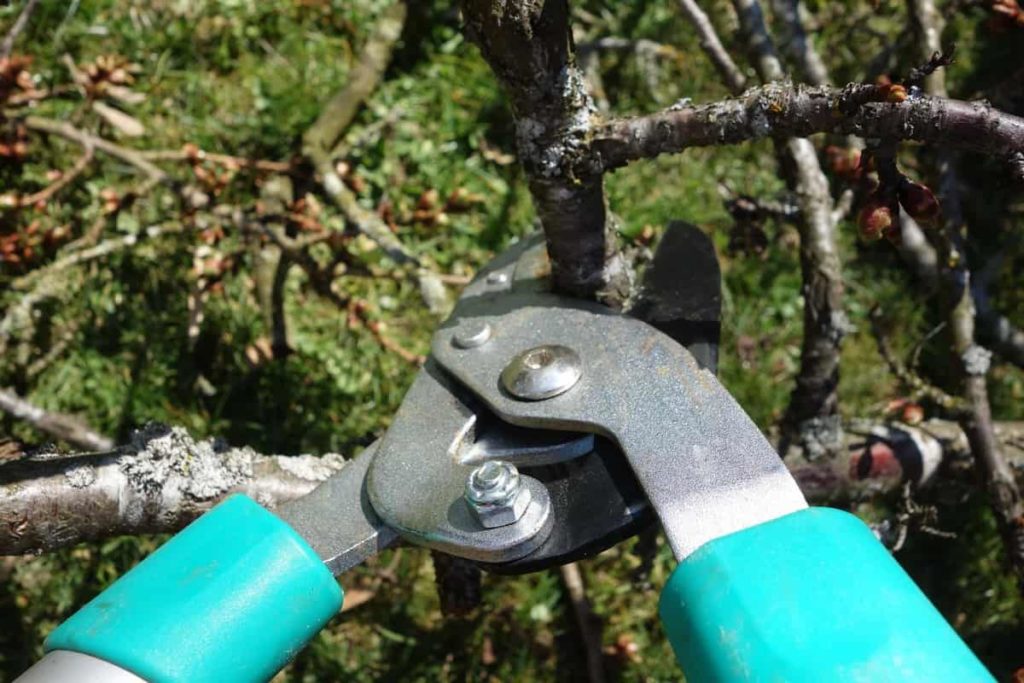
Pruning is the common method of tree care. Unlike forest trees, landscape trees require a high level of maintenance to maintain structural integrity and aesthetics. Pruning should be done to understand the tree’s biology, as improper pruning can cause lasting damage or shorten the tree’s life. Ensure proper pruning by:
- Planning and preparing before you start
- Choosing the right tools
- Identifying the plants in the garden
- Pruning at the right time
- Using the right pruning methods
- Making a clean cut to avoid stubs that are difficult to fix
- More advanced pruning methods help improve tree structure and long-term health
- You want to know why you should prune a tree
Why is pruning important in agriculture?
Promotes plant health – This removes dead and dying branches, allowing room for new growth and protecting property from damage. Also, it prevents insect and animal infestation and promotes the plant’s natural appearance and healthy growth.
Pruning changes the shape and growth of the plant. Pruning can also be considered preventive maintenance for both insect and disease damage. Many problems can be prevented by properly pruning a tree or shrub during its early years. It is the most important factor in maintaining a healthy and beautiful landscape. It is one of the best things you can do for trees.
When you prune your trees, you get all these benefits;
- Say goodbye to dead, broken, or damaged branches.
- Protect property from potential damage from falling branches.
- When you remove old plant branches, you give trees the green light for healthy, new growth.
- Train the trees to grow on their terms, so branches don’t hang over the roof or extend into power lines.
- Give trees a clean, shiny look that elevates your entire landscape.
- Plant trees with a good foundation for long-term health.
Why do you want to prune the trees?
Before you begin pruning, you want to consider what you’re trying to achieve and determine your goals. When you prune, your reasons for pruning will also be affected. You can light prune or remove dead wood any time, but if you have bigger goals, you’ll want to plan to prune around the seasons. For example, you are pruning in the winter results in an explosion of growth during the spring season.
Pruning during the summer season will slow the growth of a cut branch, so this is a good strategy for trying to shape your tree or want to reduce branch growth.
Pruning for healthy trees – Pruning for plant health focuses on removing dead and diseased branches, branches that rub together, and any branch bark so that the entire tree grows healthily. Opening the canopy to filter light and air throughout the tree reduces the disease risk and allows plant growth.
At ground level, suckers and water sprouts weaken the wood and steal nutrients from the main tree. By helping a tree establish the main tree and a dominant leader, you create a stronger tree that is ultimately better able to withstand high winds and winter storms. By pruning trees in specific ways, you can encourage fruiting and flowering, shape plants into specific shapes, and control plant size.
In case you missed it: Apple Ber Pruning Methods; Season – A Full Guide
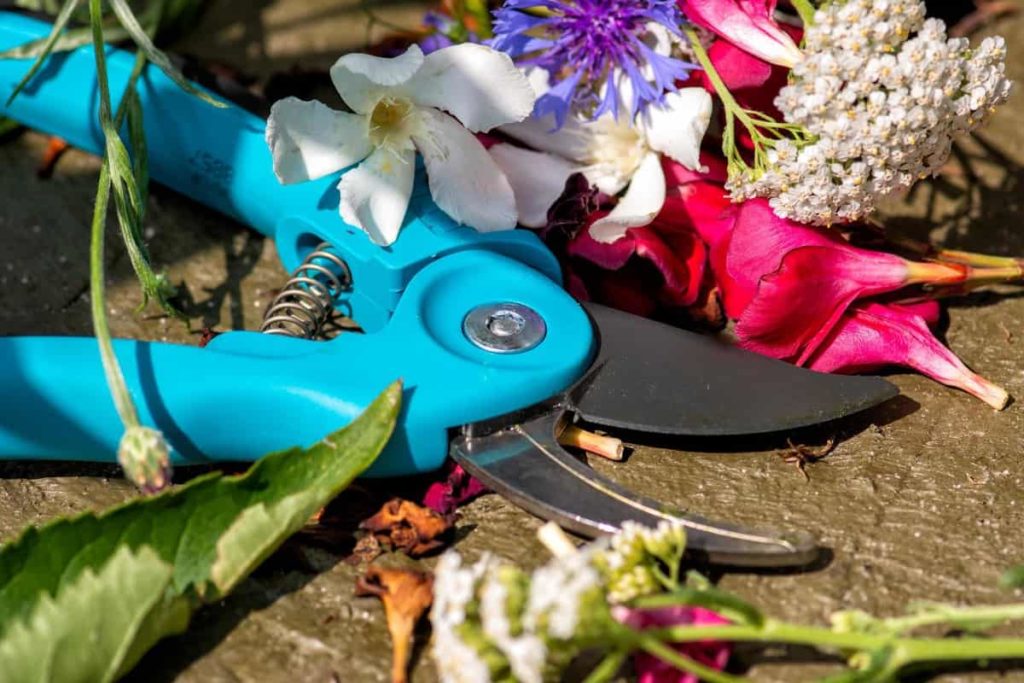
When should I start pruning?
- Tree pruning can be done mainly at any time of the year to remove damaged, dead or diseased parts.
- Trees can be pruned to a specific shape designed to be more productive or visually pleasing in the landscape. It is the standard way to remove dead and dying branches. The tendency of trees to bear fruit in alternate years can be partially corrected with pruning.
- Pruning young trees to manage their height is better than reducing the height of a mature tree.
What is the best time to prune fruit trees?
There are several reasons to prune fruit trees in the spring. For fruit trees, summer pruning in late July or August is another time to prune, but heavy pruning at this time will weaken the tree. Fruit tree pruning is the cutting and removal of selected parts of a fruit tree. It covers several gardening techniques. Pruning often means cutting back branches, sometimes removing small limbs entirely. It may also mean removing young shoots, buds, and leaves.
Winter is the best time to harvest deciduous fruit trees like apples, pears, and plums. These trees will bear fruit well whether they are pruned or not. But if the fruit trees grow too tall, the fruit is high and hard to reach, and they don’t harvest reliably when there is unproductive wood.
The goal of fruit tree pruning in the home garden is to help the tree produce crops of reliable quality, with good-sized fruit on a tree of manageable size. Good orchard hygiene is also important, so collect and dispose of after harvesting and remove any old, rotten fruit, as these can cause disease.
Should fruit trees be pruned every year?
Most fruit trees do not require annual pruning after training. Early pruning of fruit trees is important to help young trees develop dense trunks and an open canopy where light and air can enter to promote flowering and reduce fungal and bacterial diseases. Therefore, most pruning should be done in winter or spring.
Pruning reduces winter hardiness somewhat, so early winter pruning can lead to winter injury when followed by extremely cold temperatures. It takes 2 weeks for the tree to regain the winter hardiness lost due to pruning. The same tree can be cut in different ways. Pruning of fruit trees depends on the expectations of fruit tree growth and individual reasons, tree size, shape, and willingness to spend time doing the job.
A person may desire fruit trees that have a natural, unpruned appearance but may want to correct an overgrown canopy to maximize sunlight for healthy branches. Another person may desire a more manageable tree size or a tree with large, well-colored fruit. A tree harvested to maintain its natural appearance will be harvested differently than a tree cultivated primarily for fruit production.
Where should you prune a tree branch?
Proper pruning does not damage the bark of the branch or the collar of the branch. A proper cut starts just outside the bark edge of the branch and is angled down from the tree trunk, protecting the branch collar from injury. Pruning is a great way to encourage tree branches to grow. Pruning and thinning the upper story foliage can help stimulate branch growth by adding more light to a poorly performing understory tree or shrub.
How to prune a fruit tree to keep it small?
Prune to open the tree’s center and remove crossing or crowded limbs. These cuts encourage a vase-like shape. To accelerate the development of slender limbs, tilt the head two-thirds back. To slow the growth of thick limbs, tilt the head back a half. Fruit trees can be pruned to a natural shape, depending on the degree of pruning and the type of pruning cuts. This method may result in a very tall tree, but it is the easiest to achieve and is suitable for fruit trees that also serve as ornamental flowers.
A different option is a single leader tree dominated by a trunk with several side limbs growing upwards and numerous fruiting branches. The single-leader form is suitable for naturally short dwarf trees. As with most single-leader trees, more sunlight reaches the lower branches when the tree is narrow at the base.
A third option, a multiple leader system, involves two or more dominant branches that grow upward and away from the tree’s center. This shape helps maintain a small tree and is useful for trees that can get very tall, such as Plums and Peaches. The best option depends on the tree size when it is fully grown and personal preference.
In case you missed it: Grape Plant Grafting Methods; Pruning and Training
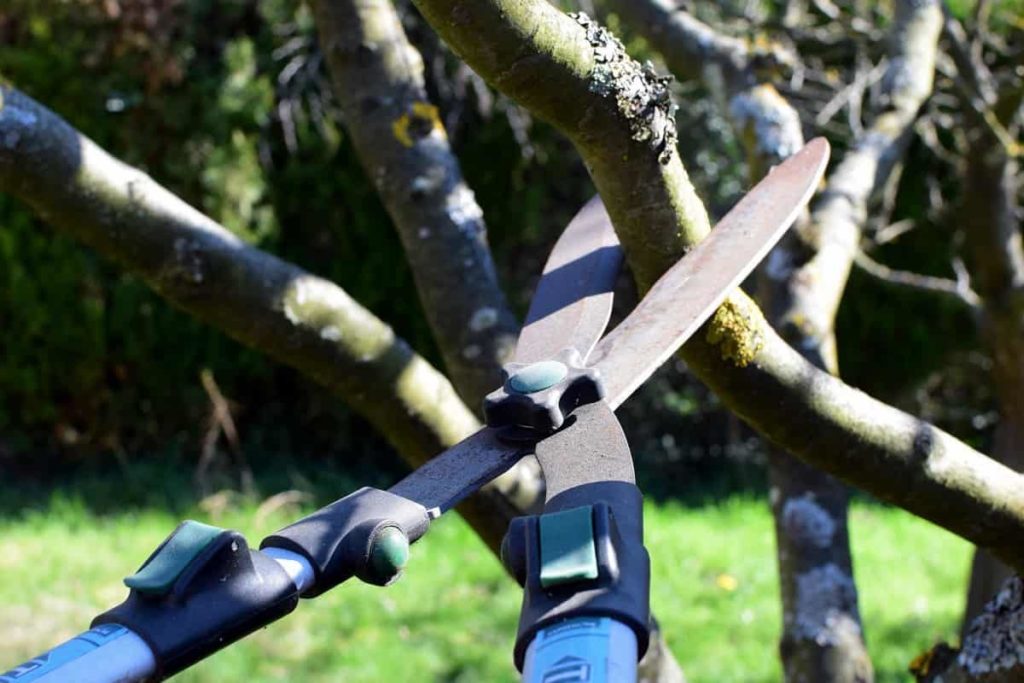
How do you tell a tree needs to be pruned?
Signs you need to prune trees are broken branches, damaged trees, dead/diseased limbs, branches over power lines, storm-damaged trees, too much growth, and weak branches.
Broken branches – The first sign of a tree that needs some pruning is broken branches. If you notice any branches that are broken, split or bent, you should prune them as soon as possible. Once these branches are broken or weakened, they become extremely dangerous. You don’t want a branch to fall on a family member, guest, or even yourself for not cutting it. Not all broken branches will be easily visible, so take an early walk around your property after every season or particularly bad storm.
Dense trees – This sign is an important one and one that you may not even notice now. Thick branches are especially dangerous during high winds or storms, with the potential for property damage. It is because branches and limbs are heavy due to their high density. Check some of your trees to avoid this. If you can’t see the branches clearly, it’s time to get out your clippers and prune.
Damaged trees – While you may appreciate the unique way your front yard tree grows, it’s not necessarily healthy for the tree. Faulty trees are trees that grow in the wrong way. Misshapen trees can damage property due to uneven weight distribution between branches. It can also cause broken or severed branches. Since pruning affects new growth, you should be sure to regularly prune and care for trees in poor shape as they may grow faster than normal. Also, you can ensure that your tree grows in good shape.
Dead/Diseased Limbs – Diseased plants and trees earlier in this article when it comes to pruning when wet. It isn’t the only time trees can get sick, so if you notice some health problems, it’s a sure sign that pruning is needed. If you don’t prune after you notice some unhealthy habits, the disease can spread quickly and even kill your tree.
Although not all trees die from the disease, you may see some dead wood. These dead branches or trunk parts can also indicate a pest problem. They remove dead or dying limbs to keep your tree happy and healthy. Like a diseased tree, if you don’t catch it and act fast enough, it can spread to the rest of the tree and cause even more damage.
When not to prune trees?
Before we get into whether your trees need pruning, let’s talk about when is the worst time of year to prune your trees. During fall, the trees look beautiful with their changing colors and falling leaves. You may want to prune crazy and help make the landscape more beautiful. But the fall season is the worst time to prune trees. Pruning encourages new plant growth. These same plants are getting ready to dormant for the coming winter months. Harvesting them now will weaken these plants.
Even though it looks like fall, some days are still quite warm. If you decide to harvest on a hot day and then the temperature drops at night, you are doing more damage to the plant. When you prune, the sap rises into the plant. Once the temperature drops below freezing, this sap freezes, creating an unsightly sight.
When it’s wet – If you have recently had a lot of rain or morning dew, avoid pruning at all costs. Pruning, when wet outside, spreads many diseases through the plants. It is due to the growth of microbes, which are stimulated by wet weather. These microbes will take advantage of new harvests and spread like wildfire. So instead, wait until the sun dries things out.
What is the best tool to prune a tree?
For the cleanest cuts, choose bypass pruners, which cut like a pair of scissors, with a curved cutting blade that passes through the wide bottom. Also called lopping shears, a lopper is the tool of choice for cutting branches up to 2 inches in diameter. The lopper label should indicate the size of the branch it will cut.
Sharp pruning tools make clean cuts, which heal quickly, reducing future problems. Clean tools are also essential for harvesting. Carry a bottle of rubbing alcohol and a rag with you, and clean the cutting surfaces of your pruning tools after you’re done with a tree or shrub. Several pruning tools can be used to make pruning easier.
It is best to hire a professional to prune the tree before attempting to prune it yourself for tall trees. While pruning, protect your eyes from injury from branches. Safety glasses are strongly recommended to prevent branches from getting into your eyes. For removing limbs and large branches, pole saws are the preferred tools. Avoid climbing trees on old branches as they have a weak structure and are likely to break. Instead, use a pole saw or tripod ladder to reach the highest branches.
What are the types of pruning?
Heading cut – Heading encourages vegetable plant growth by removing flower buds. “Heading” is usually used on plants that produce flowers you don’t want. It includes Eggplant, Pepper, and other members of the Solanaceae family. Heading can also encourage branching by removing the tip of a branch or stem, known as “crown pruning.” This technique will promote more lateral branching and produce a fuller plant.
Pinching (Removing growing tips) – You might want to pinch growing tips for various reasons. Pinching encourages your vegetable plants to grow bushier and more compact, ultimately producing more vegetables for you in less space. Vegetables like Green Beans, Peppers, and Tomatoes benefit from a pinch. Broccoli and Cauliflower are also more compact if regularly pinched.
In case you missed it: Guava Grafting Methods; Pruning Methods; Training
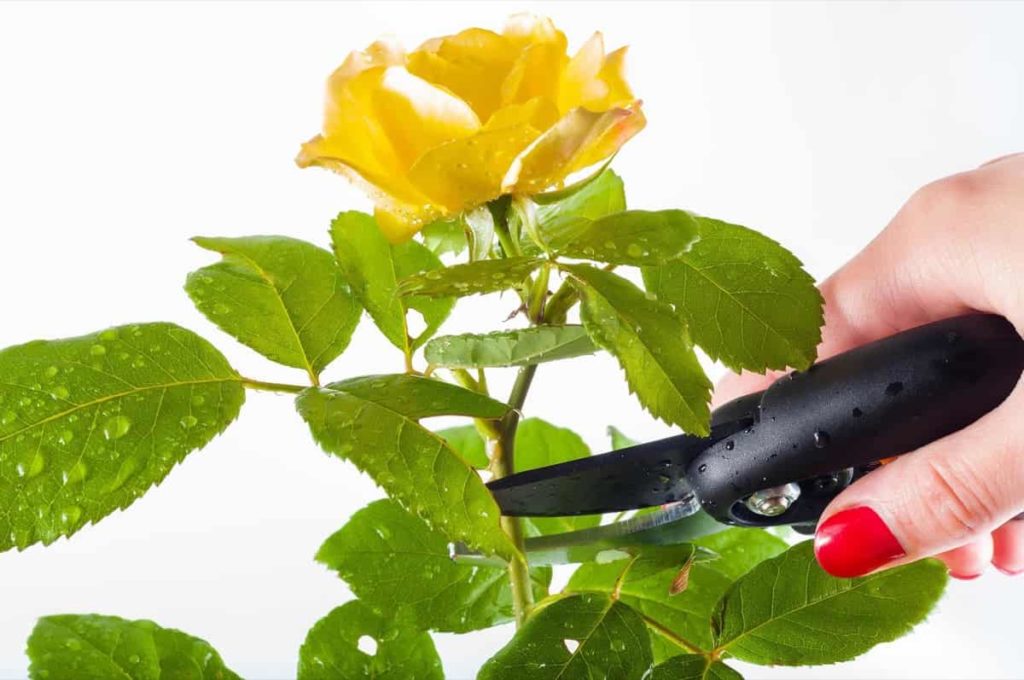
Thinning – Thinning is the selective removal of branches to increase light penetration and air movement through the crown. Thinning opens the tree’s foliage, reduces weight on heavy limbs, and helps maintain the tree’s natural shape. This pruning is used to thin the tree canopy. Following a certified arborist’s advice, a tree climber will selectively remove branches to “thin” the tree’s canopy. It allows sunlight to reach the plants and grass below and air to flow freely between the branches.
Raising – Raising removes lower branches from a tree to provide clearance for buildings, vehicles, pedestrians, and vistas.
Reduction – It reduces the size of a tree, often for clearance for utility lines. Reducing the height or spread of the tree is best accomplished by cutting the leaders into lateral branches that are large enough to handle the terminal role (at least one-third diameter cut air stem).
Dead wooding – Pruning to remove only dead, dying, and decayed branches are called “dead wooding.” It is the most practical pruning and should be done regularly to keep your trees healthy and safe.
Crown reduction – If the overall height of your trees is a concern, they are excellent candidates for crown reduction. By removing smaller branches attached to larger, heavier branches, crown reduction ensures that your trees are not too heavy. This pruning is especially important for young trees to grow bigger and stronger without all the weight of smaller branches.
Crown lifting – Crown lifting is a pruning process that removes low-hanging branches and limbs weighing down the higher branches. It is done for trees that overhang sidewalks, roads, or even your house. However, this process is more detrimental to larger, mature trees than to smaller ones. Crown lifting also allows your trees to match the rest of your landscape, keeping them well-manicured and healthy.
What vegetables should be pruned?
Tomatoes, Basil, Cucumbers, and Peppers are plants you’ll need to prune often. But others can also benefit from occasional pruning. Pruning vegetable plants is important in maintaining a healthy garden and producing the best vegetable. Other vegetables that can benefit from pruning are Gourds, Summer Squash, Winter Squash, Zucchini, and Brussel sprouts.
Do trees need to be pruned?
Pruning helps regulate the growth of trees, removes dead or diseased stems and branches, and encourages the growth of flowers, fruit, and new plants. Especially when it comes to woody plants, pruning is a great way to keep them growing healthily.
Pruning:
- Controls plant size and shape.
- Shrubby evergreens keep evergreens proportionate and dense.
- Removes unwanted branches, water sprouts, suckers, and unwanted fruiting structures that detract from the plant’s appearance.
When should vegetables be pruned?
Maximize your plant’s energy in growing, growing, and ripening fruit. You can prune year-round, but it’s generally accepted in early spring – just before new growth and harvest. Pruning is useful to maintain the health of a vegetable plant and prevent it from overgrowing. When pruned, plants are encouraged to grow in their natural form instead of being lanky.
How do you prune Tomatoes?
To grow the strongest tomato plant, prune the side below the first fruit cluster. As the tomato plant matures, the lower leaves begin to turn yellow. Prune or pinch yellow leaves to prevent disease, improve the appearance of the tomato plant, and help with fruit formation.
What happens if you don’t prune trees successfully?
If not pruned after you notice some unhealthy habits, the disease can spread quickly and even kill your tree. You want to consider removing the tree altogether. Although not all trees die from the disease, you may see some dead wood.
Do trees grow back after pruning?
When properly pruned, removed tree branches will not regrow. Instead, the tree will grow into what looks like a thorn when harvested, which helps protect the tree from rot and infection.
What is the difference between pruning and trimming?
They refer to very different methods with entirely different objectives. There is a good reason for this confusion because both usually involve cutting at least one part of the plant. Pruning usually involves removing dead or diseased wood and thinning trunks and branches to improve plants’ overall health and appearance.
Trimming, on the other hand, usually involves cutting plant material for reasons other than health concerns. It can improve the overall appearance of a shrub or tree or give it a specific shape required for its intended use. Trimming is done primarily for appearance, while pruning is done for health.
When is the best pruning time for flowering trees?
- March is the best time to prune many trees.
- Late winter pruning follows the damaging cold spell of deep winter and ensures that pruning wounds are quickly healed by new growth, reducing the chance of disease and drying out.
These rules to keep in mind when deciding on pruning trees;
- Keep trees healthy – Remove all dead, diseased, or injured branches.
- Keep trees strong – Remove the length of stems that compete with the main leader.
- Keep it consistent – Remove tree branches that cross or touch each other and any that look out of place.
In case you missed it: Jasmine Grafting; Pruning; Training Methods
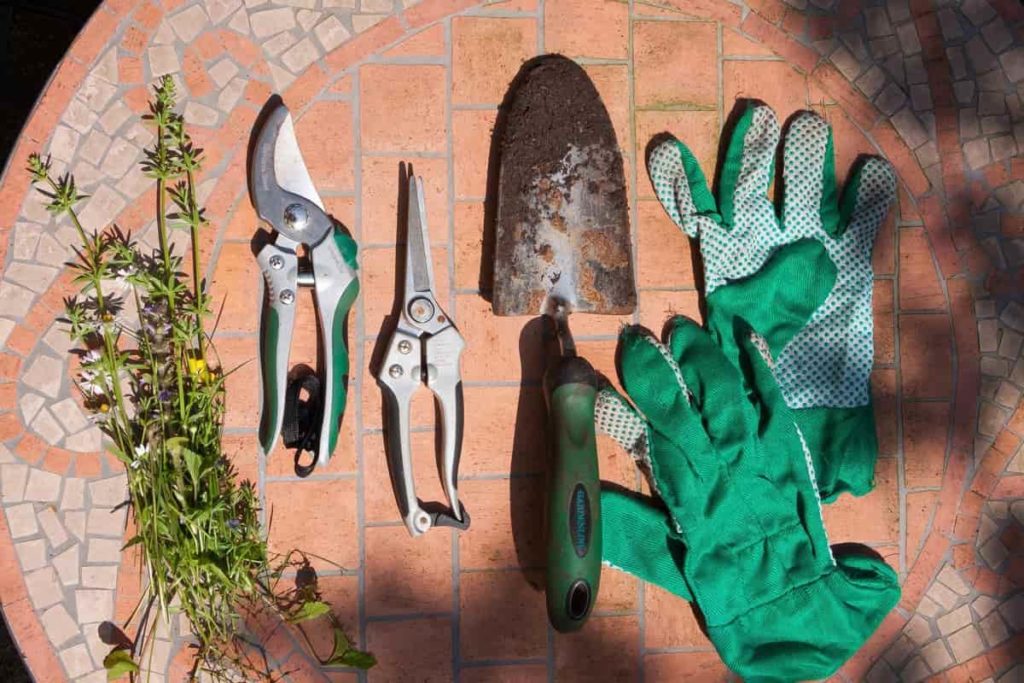
What to put on trees after pruning?
- Pruning paint can hinder healing and encourage the growth of decay organisms and insects.
- Instead of eliminating the infection, the wound dressing often becomes moist and rotten. It is best to let the wounds heal on their own.
Conclusion
Prune a tree to remove damaged branches, new growth, or to create a specific shape. It is an essential gardening skill. When you prune trees correctly, you encourage healthy growth, blooms (in the case of flowering plants), and good looks. Most shrubs and trees, it mainly helps to prune at the right time. Some are best pruned in the winter season, shortly after flowering. Pruning is common in orchard and vineyard management to improve flowering and fruiting.
- How to Build a Low-budget Goat Shed: Cheap Ideas and Tips
- Goat Farming Training Programs in India: A Beginner’s Guide
- Types of Pesticides Used in Agriculture: A Beginner’s Guide
- Economical Aquaculture: A Guide to Low-Budget Fish Farming
- 15 Common Planting Errors That Can Doom Your Fruit Trees
- How to Make Houseplants Bushy: Effective Tips and Ideas
- Innovative Strategies for Boosting Coconut Pollination and Yield
- Pollination Strategies for Maximum Pumpkin Yield
- The Complete Guide to Chicken Fattening: Strategies for Maximum Growth
- Natural Solutions for Tulip Problems: 100% Effective Remedies for Leaf and Bulb-Related Issues
- Revolutionizing Citrus Preservation: Towards a Healthier, Greener Future
- Natural Solutions for Peony Leaf and Flower Problems: 100% Effective Remedies
- Maximizing Profits with Avocado Contract Farming in India: A Comprehensive Guide
- Natural Solutions for Hydrangea Problems: 100% Effective Remedies for Leaf and Flowers
- The Ultimate Guide to Choosing the Perfect Foliage Friend: Bringing Life Indoors
- From Sunlight to Sustainability: 15 Ways to Use Solar Technology in Agriculture
- The Ultimate Guide to Dong Tao Chicken: Exploring from History to Raising
- The Eco-Friendly Makeover: How to Convert Your Unused Swimming Pool into a Fish Pond
- Mastering the Art of Delaware Chicken Farming: Essentials for Healthy Backyard Flocks
- 20 Best Homemade Fertilizers for Money Plant: DIY Recipes and Application Methods
- How to Craft a Comprehensive Free-Range Chicken Farming Business Plan
- Brighten Your Flock: Raising Easter Egger Chickens for Beauty and Bounty
- How to Optimize Your Poultry Egg Farm Business Plan with These Strategies
- Subsidy for Spirulina Cultivation: How Indian Government Schemes Encouraging Spirulina Farmers
- Ultimate Guide to Raising Dominique Chickens: Breeding, Feeding, Egg-Production, and Care
- Mastering the Art of Raising Jersey Giant Chickens: Care, Feeding, and More
- Ultimate Guide to Raising Legbar Chickens: Breeding, Farming Practices, Diet, Egg-Production
- How to Raise Welsummer Chickens: A Comprehensive Guide for Beginners
- How to Protect Indoor Plants in Winter: A Comprehensive Guide
- Ultimate Guide to Grow Bag Gardening: Tips, Tricks, and Planting Ideas for Urban Gardeners
- Guide to Lotus Cultivation: How to Propagate, Plant, Grow, Care, Cost, and Profit
- Agriculture Drone Subsidy Scheme: Government Kisan Subsidy, License, and How to Apply Online
- Ultimate Guide to Raising Araucana Chickens: Breed Profile, Farming Economics, Diet, and Care
- Bringing Hydroponics to Classroom: Importance, Benefits of Learning for School Students
- Ultimate Guide to Raising Polish Chickens: Breed Profile, Farming Economics, Diet, and Care
- Ultimate Guide to Raising Australorp Chickens: Profile, Farming Economics, Egg Production, Diet, and Care